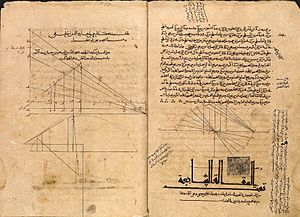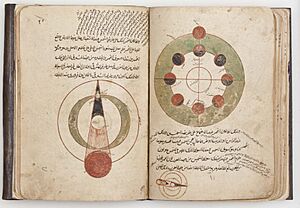Timeline of science and engineering in the Muslim world facts for kids
This article is a timeline of cool discoveries and amazing inventions made by scientists and engineers in the Muslim world. It covers a long period, from the 700s AD all the way until the 1800s, when European science started to become more common. All the dates you see here are based on the Gregorian calendar, which is the one most of the world uses today.
Contents
- The Eighth Century: Early Discoveries
- The Ninth Century: New Ideas and Tools
- The Tenth Century: Numbers and Calculations
- The Eleventh Century: Math and Poetry
- The Twelfth Century: Mapping the World and New Algebra
- The Thirteenth Century: Engineering, Medicine, and Astronomy
- The Fourteenth Century: Observatories and Decimals
- The Fifteenth Century: Math Symbols
- The Seventeenth Century: More Math and Globes
- Modern Science: Continuing Contributions
- Images for kids
- See also
The Eighth Century: Early Discoveries
In the 700s, smart people in the Muslim world were already making big steps in science!
Amazing Astronomers
- Died 777 AD: Ibrāhīm al-Fazārī was a mathematician and astronomer who worked for the Caliph Al-Mansur. He wrote books about tools like the astrolabe and how to make calendars.
- Died 796 or 806 AD: Muḥammad ibn Ibrāhīm al-Fazārī was Ibrahim's son. He was also a philosopher, mathematician, and astronomer. He helped translate important Indian science books into Arabic. He's also believed to have built the first astrolabe in the Islamic world! This helped bring Hindu numerals (the numbers we use today) from India to the Muslim world.
Mind and Body
- 654–728 AD: Ibn Sirin was a Muslim mystic who lived in the 700s. He was known for interpreting dreams.
Math Wizards
- 780–850 AD: Al-Khwarizmi was a super important mathematician. He developed something called "al-jabr," which we now call algebra! Algebra helps us solve problems with unknown numbers.
The Ninth Century: New Ideas and Tools
The 800s saw more exciting developments, especially in chemistry and math.

Chemistry and Health
- 801–873 AD: Al-Kindi wrote about how to make perfumes and distil liquids like rose water. He shared 107 recipes for perfumes!
- 865–925 AD: Al-Razi was a chemist and doctor. He wrote about petroleum and how to distil it. When he needed to choose a place for a hospital in Baghdad, he hung meat in different spots. The place where the meat rotted slowest was chosen because it was the cleanest! He also wrote about chemicals like soap and glycerine.
Math Discoveries
- 826–901 AD: Thābit ibn Qurra studied in Baghdad. He found a special rule to discover pairs of "amicable numbers." These are two different numbers where the sum of the numbers that divide evenly into the first number (not including the number itself) equals the second number, and vice versa.
Amazing Inventions
- Around 810 AD: The Bayt al-Hikma (House of Wisdom) was set up in Baghdad. This was a huge library and research center where Greek and Indian math and astronomy books were translated into Arabic.
- 810–887 AD: Abbas ibn Firnas was a creative inventor. He built a planetarium and even tried to fly with wings!
The Tenth Century: Numbers and Calculations
By the 900s, people in the Arab world used different ways to count.
Chemistry Insights
- 957 AD: Al-Masudi wrote about how alkali water reacts with vitriol (a type of salt) to make sulfuric acid.
Math Innovations
- 920 AD: Al-Uqlidisi changed how people did math with Indian numerals. Before him, you needed a special dust board to move numbers around. He made it possible to do calculations with pen and paper!
- Born 940 AD: Abu'l-Wafa al-Buzjani was an expert in different counting systems, including the Indian numerals. He showed how to find roots using the Indian numeral system.
- 980 AD: Al-Baghdadi studied amicable numbers and compared the different counting systems used at the time.
The Eleventh Century: Math and Poetry
The 1000s brought a famous mathematician who was also a poet.
Math and Art
- 1048–1131 AD: Omar Khayyam was a Persian mathematician and poet. He found ways to solve complex math problems called cubic equations using geometry. He also used the decimal system (our number system today) to find roots of numbers.
The Twelfth Century: Mapping the World and New Algebra
In the 1100s, maps became better, and algebra continued to grow.
Mapping the World
- 1100–1165 AD: Muhammad al-Idrisi was a famous mapmaker from Andalusia (Spain) and Sicily. He created some of the most detailed and advanced world maps of his time.
Algebra Advances
- 1130–1180 AD: Al-Samawal was a key figure in the study of algebra. He defined algebra as working with unknown numbers using all the tools of arithmetic.
- 1135 AD: Sharaf al-Din al-Tusi wrote an important book about cubic equations. His work helped connect algebra with geometry, which was a big step towards what we now call algebraic geometry.
The Thirteenth Century: Engineering, Medicine, and Astronomy
The 1200s were a time of amazing inventions, medical breakthroughs, and deeper understanding of the stars.
Chemistry and Materials
- Al-Jawbari wrote about how to prepare rose water.
- Arabic writings from this time describe how to make fake gemstones and even diamonds! They also talk about chemicals like sulfuric acid and hydrochloric acid.
Math Puzzles
- 1260 AD: Al-Farisi found a new way to prove a theorem about amicable numbers. He also found a pair of amicable numbers (17296 and 18416) that were later also found by famous mathematicians like Fermat.
Stargazing and Textbooks
- Jaghmini wrote al-Mulakhkhas fi al-Hay’ah (Epitome of Plain Theoretical Astronomy). This astronomy textbook was so good that it was used for teaching until the 1700s!
Clever Machines and Medicine
- Mechanical Engineering: Ismail al-Jazari described 100 different mechanical devices, including many clever "trick vessels," and gave instructions on how to build them.
- Medicine and Science: Ibn Al-Nafis (1213–1288) was a doctor and anatomist from Damascus. He made an incredible discovery: he figured out how blood flows through the heart and lungs, which is called the lesser circulatory system. He explained that blood is cleaned in the lungs to keep us alive and give our bodies energy. Before him, people had different, incorrect ideas about how blood moved. Ibn al-Nafis used careful observation and experiments to prove his ideas, showing how important it is to test what you believe.
The Fourteenth Century: Observatories and Decimals
The 1300s saw the building of a major observatory and progress in how numbers were written.
Astronomy Hubs
- 1393–1449 AD: Ulugh Beg built an important observatory in Samarqand (which is now in Uzbekistan). This was a place where astronomers could study the stars and planets.
Decimal System
- 1380–1429 AD: Al-Kashi made big contributions to how we use decimal fractions. He helped develop them not just for estimating numbers, but also for real numbers like pi. He also created a method for calculating roots of numbers, which was similar to methods developed much later by other mathematicians.
The Fifteenth Century: Math Symbols
In the 1400s, math started to look more like it does today.
Symbols in Math
- Ibn al-Banna and al-Qalasadi started using symbols for mathematics. We don't know exactly when this began, but we know symbols were used at least a century before this time. This made math easier to write and understand.
The Seventeenth Century: More Math and Globes
The 1600s continued to see mathematical discoveries and beautiful scientific instruments.
Amicable Numbers Again
- The Arabic mathematician Mohammed Baqir Yazdi discovered another pair of amicable numbers: 9,363,584 and 9,437,056. He shares credit for this discovery with the famous mathematician Descartes.
Celestial Globes
- In 1663, a beautiful celestial globe (a model of the sky with stars) was made by Diya’ ad-din Muhammad in Lahore (now in Pakistan). This globe is now in the National Museum of Scotland. It's a great example of the detailed and artistic scientific tools made during this time.
Modern Science: Continuing Contributions
Muslim scientists have kept making huge contributions to modern science, even today!
- Abdus Salam helped develop the theory of how two fundamental forces of nature (electromagnetism and the weak nuclear force) are connected.
- Ahmed Zewail developed femtochemistry, which lets us study chemical reactions happening incredibly fast.
- Moungi Bawendi invented quantum dots, tiny particles used in things like TVs and medical imaging.
- Lotfi A. Zadeh developed fuzzy set theory, which helps computers deal with information that isn't perfectly clear.
- Mehran Kardar introduced the Kardar–Parisi–Zhang equation, important in physics.
- Alireza Mashaghi developed Circuit topology.
- Hulusi Behçet was the first to describe Behçet's disease, a rare disorder.
These amazing contributions have been recognized with 4 Nobel Prizes, with Abdus Salam being the first Muslim to win a Nobel Prize in science.
Images for kids
-
The Conica by Apollonius of Perga, a famous Greek book about shapes, was translated into Arabic in the 800s.
See also
- Arab Agricultural Revolution
- Islamic Golden Age
- Science in the medieval Islamic world
- Ibn Sina Academy of Medieval Medicine and Sciences
- List of inventions in the medieval Islamic world




